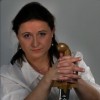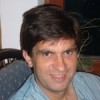Two members of the audience were unimpressed with Mark Childress’ lecture at TM-Europe. When he started speaking both looked up and showed a mild interest in this tall American with a deep voice who regularly quotes someone called Yogi Berra, allegedly a baseball philosopher. However, when Mark started talking our two unimpressed audience members seemed to take the view that terminology was worthy but dull and settled down to have a snooze. These two members of the audience were dogs. The people in the audience heard an excellent lecture on terminology. Kevin Lossner, who owns these two dogs will probably protest that they were in fact incredibly interested in everything that went on at TM-Europe 2012, but we know he’s lying.
Mark was the keynote speaker who opened TM-Europe 2012. The conference theme was The Future of Translation and we wanted to make a point by having a presentation on terminology open the conference. Mark gave a lecture and a very interesting lecture it was too. He brought up major issues with how terminology is used with real examples. He discussed how terminology can bewilder as well as inform. He also gave examples where using the terminology which is commonly understood rather than the terminology of the experts can save lives.
There is a lot of discussion at other conferences and on social and other media about the future of translation. Some commentators paint a future of automated, commoditized, lower quality translation. The people who are suggesting this is the future look like they know what they are talking about. This future of large LSPs brokering translation and machine translation vendors automating all in sight looks impressive. To paraphrase a wonderful line from Raymond Chandler: From thirty feet away they look like a lot of class. From ten feet away they look like they were meant to be seen from thirty feet away.
At TM-Europe we were discussing a different future. It was a future where words matter, language matters and there is absolutely nothing wrong with aiming for excellence. The second keynote speaker, Chris Durban made a very strong case for this pursuit of excellence and the premium market. Chris is an international business woman, a business analyst, a marketing expert, an entrepreneur and she has the words ‘Freelance Translator’ written on her business card. Her presentation received a lot of attention on twitter and in other blogs. Chris’ message is about being focused, being specialized and aiming for the premium market. She showed how she helped her clients to realize the importance of translation. Her stories of winning business always seemed to start with respect for the client and an understanding of their issues. She mentioned signing your work as way of taking responsibility for quality.
Stefan Gentz gave an excellent presentation on Change Management. He illustrated how we all have slightly different perspectives by asking everyone to stand up close their eyes and point north. As you can imagine not everyone was pointing in the same direction.
Reinhard Schaler took one particular aspect of the future, Social Localisation as the topic for his presentation. It is often the case when Reinhard gets up to speak he uses a video or music clip to illustrate his point. This time he used Randy Newman’s song Political Science (No one likes us – I don’t know why!) to illustrate the ‘Why don’t they just speak English’ attitude of some developers. Reinhard’s account of TM-Europe is available here: http://reinhardschaler.wordpress.com/2012/10/06/no-one-likes-us-i-dont-know-why-tm-europe-warsaw-3-4-october-2012/
Alain Chamsi, CEO, JiveFusion Technologies, Martin Beuster of Context and Doug Strock of Global Language Translations and Consulting gave excellent presentations on process and project management. The Technology Showcase had presentations from Paul Filkin of SDL, Gábor Ugray of Kilgray and Bastian Enners of Plunet. This was followed by an overview of research in NLP and other technologies from Dr. Maciej Ogrodniczuk of the Polish Academy of Science and Piotr Pęzik, of the University of Łódź.
Kevin Lossner, the owner of the dogs mentioned above, said somewhere his presentation was a rant. I am not sure of this but it certainly was a lively heart full opinion on a range of subjects. He wrote about it on his blog: http://www.translationtribulations.com/2012/10/the-buck-stops-where.html. Kevin spoke together with Doug Strock and Michal Tyszkowski of Centrum Lokalizacji C&M on a panel dealing with machine translation. The title of this presentation asked whether MT was hype. The discussion here had little hype and those using MT had a very realistic view of how it can be used. Michal compared it to packet soup. He pointed this was widely used a base ingredient for other things and rarely used on its own. Michal claimed the same was true of MT.
We had hoped that the translator, Miguel Llorens would join us for the MT panel and for The Warsaw Pact Debate. Sadly he died a few weeks before the conference. We used a presentation made up of twitter and blog quotes from Miguel as a background for the MT debate. As I got to decide which quotes to use I was able to include one of my favourite tweets from him which had absolutely nothing to do with the subject being discussed: The main question archaeologists of the future will have about our civilization: "Why did they have so many goddamned headphones?"
You can download the full presentation of Miguel quotes here: http://www.tm-europe.org/sites/default/files/Miguel-quotes.pptx
I took part in another panel discussion on standards along with Jerzy Czopik,Freelance Translator and Odette LIÉTAR of IDEST. Monika Popiolek chaired this lively discussion where there were many interesting contributions from the floor.
The conference ended with The Warsaw Pact Debate. We had Chris Durban, Mark Childress, Doug Strock and Reinhard Schaler. I only realized later that this combination of translator, end customer, lsp and academic was perfectly balanced. However, that was not the reason we picked these people. We picked them because we thought they would have some interesting things to say. They did! It was a very lively and interesting debate. One of the things I got out of this is marketing is crucial to improving your business and career and you need to allocate time for marketing.
This was the fifth TM-Europe conference. Susan Starling suggested that with the amount of people blogging about TM-Europe it might lose its reputation as the best kept secret of translation Industry conference. It would be great to welcome more people next year as well as welcome back those who attended this and previous year. I would to thank everyone who made it a successful conference, the programme committee of Mark Childress, Kevin Lossner, Monika Popiolek and myself, the speakers, those who blogged and tweeted and above all those who came to the conference.
See you for TM-Europe 2013.
Reinhard’s blog
http://reinhardschaler.wordpress.com/2012/10/06/no-one-likes-us-i-dont-know-why-tm-europe-warsaw-3-4-october-2012/
Kevin’s blog on TM-Europe
http://www.translationtribulations.com/2012/10/the-future-of-translation-now-in-warsaw.html
Kevin’s blog on Kevin’s presentations
http://www.translationtribulations.com/2012/10/the-buck-stops-where.html
Valerij Tomaranko’s blog
http://anmerkungen-des-uebersetzers.com/2012/10/08/tm-europe-2012-putting-a-face-to-a-name/
Jayne Fox’s blog
http://foxdocs.biz/BetweenTranslations/the-bulk-vs-premium-translation-market-inspiration-from-the-tm-europe-twitter-stream/
TM-Europe Facebook Album (thanks to Stefan Gentz)
https://www.facebook.com/media/set/?set=a.189691217832483.46812.100003748172867&type=1&l=34bf32297f







